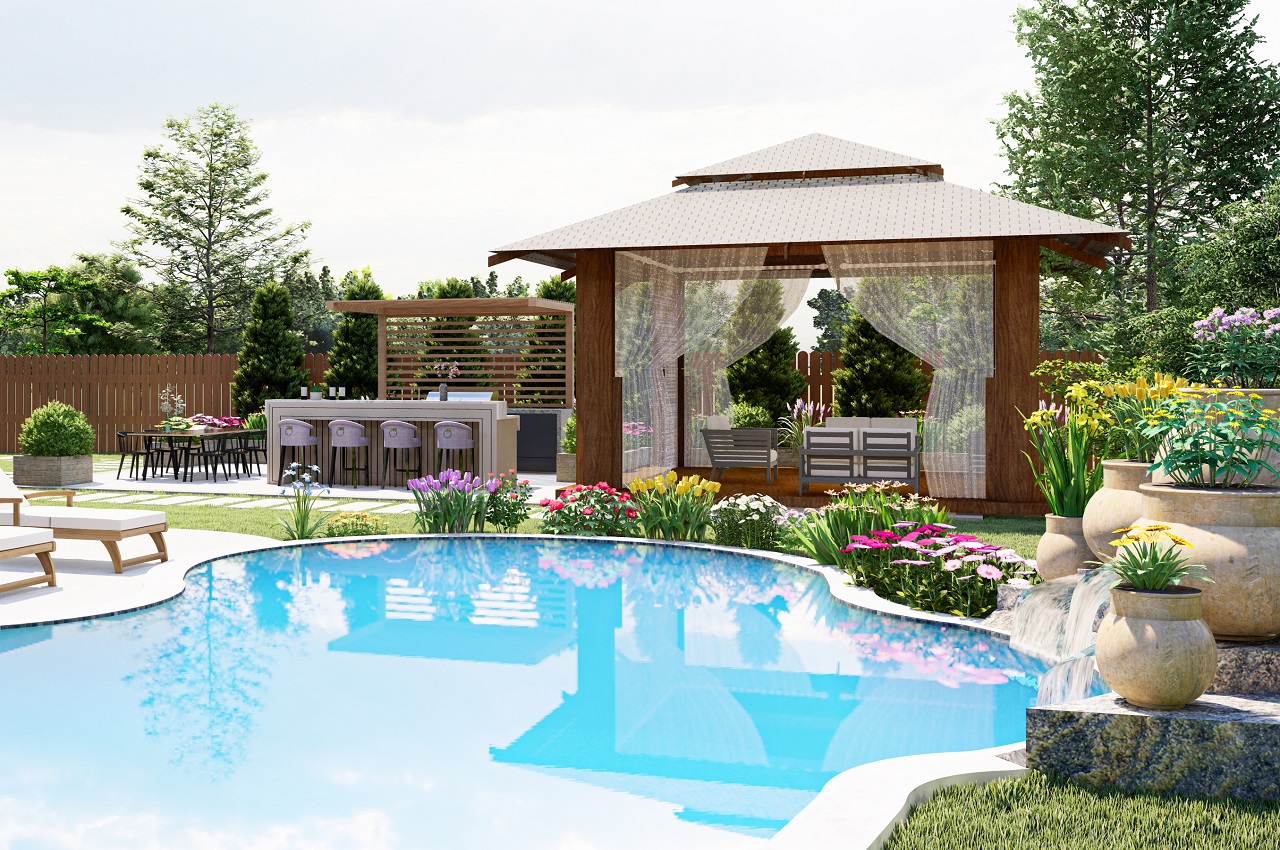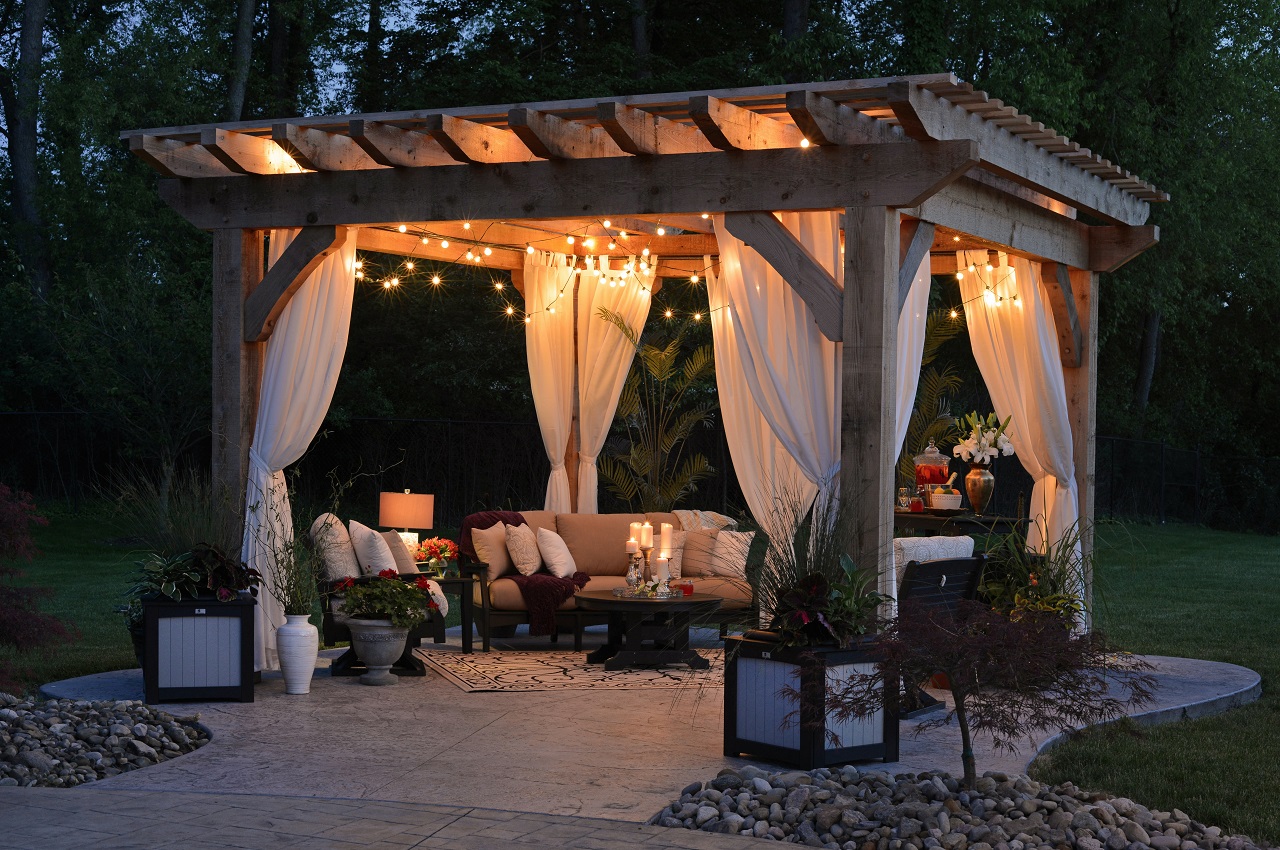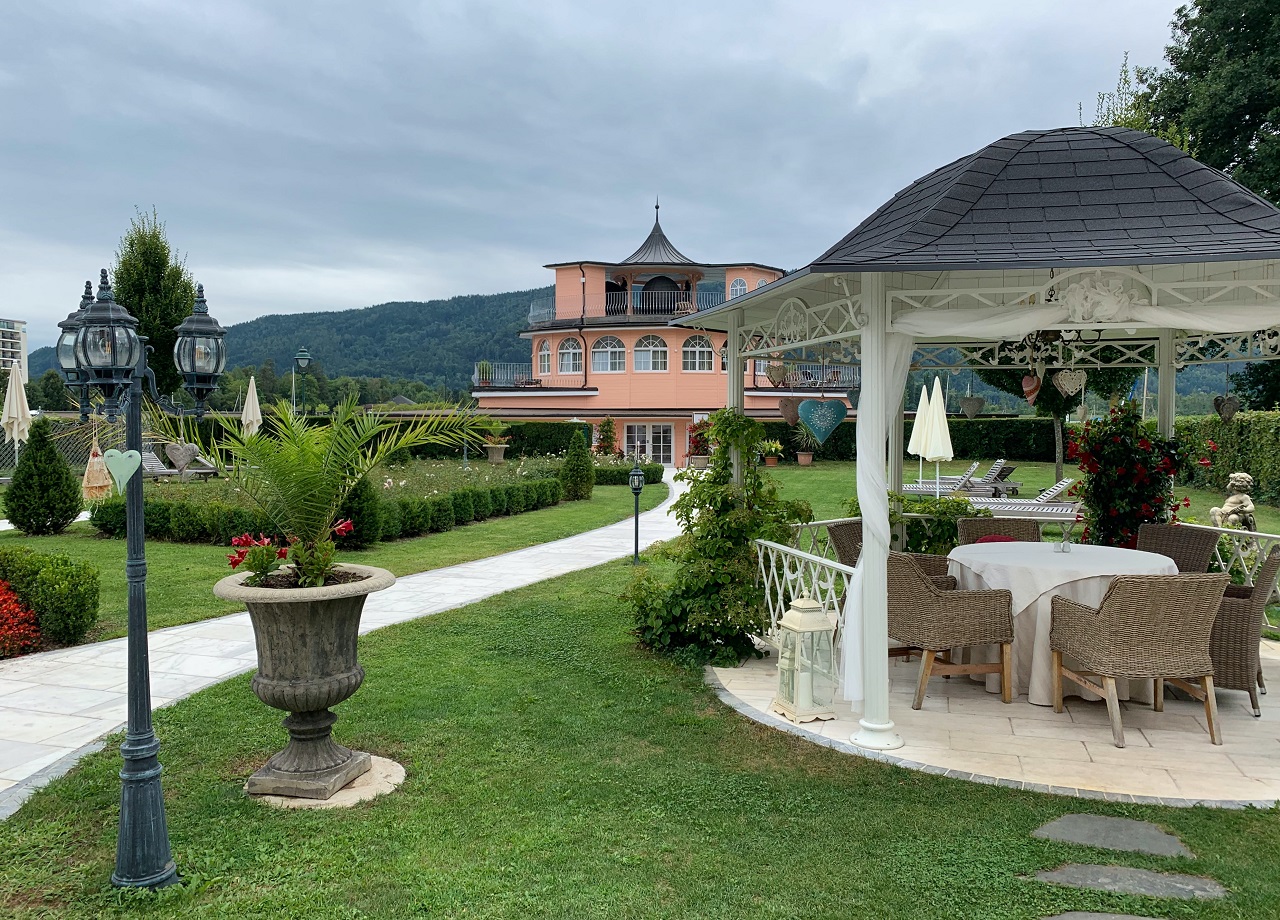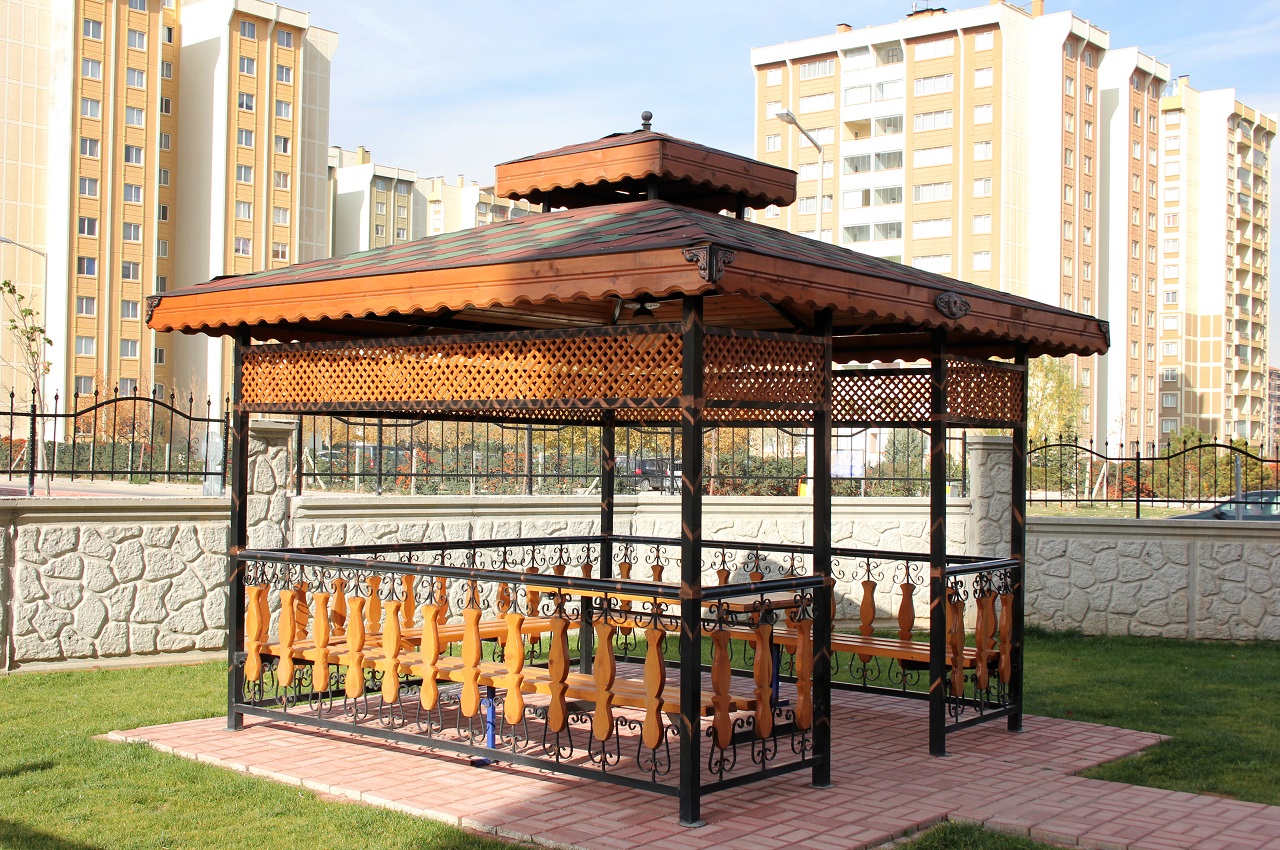Nothing quite like a gazebo can make your garden appealing as far as landscaping is concerned.
Offering refuge, shade, and shelter, gazebos attract people to spend time outside the 4 walls of their homes. Besides adding an old-world charm, they increase the property value– so there’s every reason to add these open structures to your garden, backyard, or other outdoor spaces.
Continue reading to learn about gazebos and their uses.
Gazebo 101 | What Is A Gazebo?

A gazebo is an open, freestanding garden structure or living space that provides shelter, shade, and an area to sit where homeowners can enjoy the beauty of their garden. Garden gazebos are called open structures because they are open from 4 sides but have a roof.
Besides enhancing the beauty of the landscape, gazebos are a great way to create a personalized area in your backyard. It serves as a perfect space for entertaining guests, seeking shade, or resting with the family.
They are typically geometric in design and come in an array of shapes and sizes, such as rectangular, hexagonal, and several other shapes. Classic gazebos are octagonal in shape, with a railing around the perimeter, poles in all 8 corners, and a roof (shingled) with a small dome top.
Construction
As for the construction, gazebos are constructed of 3 materials: metal, wood, and vinyl. Compared to wood, metal gazebos are long-lasting, meaning they will withstand the natural elements and insect attacks instead of succumbing to them. What’s more, metal gazebos are easy to maintain, as they only require occasional cleaning to retain their natural beauty and keep them free from dust.
Crafted out of wood, wooden gazebos are available in plenty of styles; however, the type of wood used in the construction determines the durability and longevity of the gazebo. Of all, I’ve found gazebos made of Southern Yellow Pine are highly resilient. Southern Yellow Pine, refers to a collection of tree species instead of a single species.
An excellent alternative to a wooden gazebo is a vinyl gazebo, which has skyrocketed in popularity because it’s low-maintenance. Unlike wooden gazebos, which are susceptible to insect or termite attacks and rotting, vinyl gazebos are resistant to them.
Vinyl gazebos are usually made of high-quality resin to ensure the structure doesn’t turn yellow, fade or crack due to exposure to elements. Moreover, they can be customized to a large or a small gazebo, depending on what a homeowner needs.
Most gazebos feature drapes, classic fencing, and built-in seating, creating a sense of privacy. Many hot tub owners go for such gazebos because they offer them a private place where they can change into their swimwear.
A Brief History Of Gazebos: Where Did They Originate?
Often called pagodas, arbors, pergolas, pavilions, kiosks, and summerhouses, these freestanding structures have graced the world for 5 millennia. Interestingly, the primeval gazebos bore a strong resemblance to the turrets found on roofs and were used to provide shade and basic shelter.
But back in the day, gazebos weren’t recognized as gazebos; they were only called so in the 18th Century. The term “gazebo,” perhaps, originated from the two words “gaze” and “ebo”– the Latin suffix, which means “I shall.”
Be it small or large, gazebos were a prominent garden element in Rome and Ancient Egypt because they were an excellent outdoor space to unwind and enjoy scenic views. Even in traditional Asian tea ceremonies, gazebos were used.
Throughout history, gazebo-like structures have been seen in several countries. In the late 19th Century and early 20th Century, small towns and cities had huge gazebos either in the park or the town center, which often doubled as bandstands.
That said, here are the countries where gazebos were prominent in the olden days.
1. Rome And Greece
For the people of Rome, gardens served as a relaxing and entertaining space, especially among the affluent, dwelling close to the Mediterranean. Hence, garden gazebos were built in ancient Rome as gathering places and as an aesthetic outdoor element.
Throughout ancient Greece and Rome, gazebos were constructed for public use. Often, they were built near temples and were carved out of marble. Ancient Greeks constructed temples in open spaces enveloped by gardens, where gazebos were incorporated in commemoration of gods and goddesses.
2. England
In England, gazebos became prevalent in the 16th Century and remained popular throughout the 18th Century. During this period, it is said that gazebos were seen in vast private estates or parks.
Only in the 19th Century were gazebos created for middle-class estates or premises. At that time, they were seen more as a shelter than a picturesque architectural component and even the traditional afternoon tea was served in gazebos.
3. Medieval And Renaissance Periods
Even though gazebos rose to popularity because of their aesthetics, they were primarily constructed to offer privacy. These freestanding outdoor structures were used in monasteries and churches as areas to construct shrines or for meditation.
These retreats were created in more remote parts of big estates throughout Medieval and Renaissance Europe. In those times, gazebos functioned as a venue for the landholder of the rural estate or lord of the manor, and their visitors would stroll outdoors while being covered by a roof.
4. Asia
Teahouses– also spelled as tea houses– are a type of pavilion structure or gazebos that were widespread in Japan and China for more than a century. For ages, tea ceremonies have been a time of reflection, meditation, and rest while rejoicing in loved ones’ presence and appreciating the beauty of nature in Japan.

Different Types Of Gazebos
As previously mentioned, gazebos are available in varying shapes, sizes, and materials. While some gazebos are dodecagonal, others are oval or rectangular.
Besides classic wood, gazebos are available in aluminum and modern vinyl styles. Even the type of roofing differs, with some having pinnacle roofs and others having industrial-style roofs.
Homeowners looking for a beautiful gazebo to add to their big or small yard are bound to get confused with the varieties available. But don’t worry, for I’ve discussed the different types of gazebos homeowners can consider for spending time outdoors.
1. Pavilion
With a large structure, side walls, and a roof, pavilions are regarded as the quintessential gazebos.
These open-air structures are rectangular in shape and are supported by 4 columns. A simple roofing system added to the structure offers instant shade and protection from the natural elements.
From musical performances to weddings, pavilions are used for numerous purposes.
2. Pergola
People add pergolas to their property because they make the pathway inviting while offering a cozy space to sit and relax in the lap of nature. What makes pergolas a popular structure is that they support hanging or climbing plants like vines.
Homeowners looking for options to spruce up their outdoor space must go for pergolas.
3. Arbor
Quite similar to a pergola, arbors are often regarded as mini gazebos.
Typically, these open lattice structures are made of metal or wood and feature built-in seating. Because of their aesthetic beauty, they are often used to create stunning entryways into gardens.
Common Shapes Of Gazebos
Traditional gazebos were either octagonal in shape or rectangular. However, in contemporary times, gazebos come in a variety of shapes and sizes, offering homeowners a range of options to choose from.
Some of the popular shapes of gazebos are as follows:
1. Oval Gazebos
Perhaps the most classic types, oval gazebos feature a domed roof and 8 support columns, which is why they are stable and highly durable.
2. Rectangular Gazebos
As is understood, rectangular gazebos are rectangular with 2 gable ends. These gazebos make for an excellent choice for homeowners who want to maximize the inner space of the gazebo.
3. Square Gazebos
Although similar to a rectangular-shaped gazebo, a square gazebo features equal sides. Square gazebos, like rectangular gazebos, have plenty of space inside, which is why they can accommodate outdoor furniture.
Hence, they are perfect for relaxing or entertaining guests in the backyard.
4. Octagonal Gazebos
Quite similar to round or oval gazebos, octagonal gazebos feature a dome and 8 sides instead of the conventional 4 sides. The roof also has other ornamental elements that enhance the beauty of the structure.
Such a foundation allows for an additional inside area, which would be useful for those who plan to use it for entertainment purposes.
5. Modern Asymmetrical Gazebos
Today, designers are experimenting with gazebos by introducing them in unique shapes. That means contemporary gazebos are lopsided– they lack symmetry and are presently available in all shapes and forms.
From dramatic to minimalistic to curved walls and roofs, getting a gazebo that serves as the focal point of your property has become easier than ever.

What Are The Uses Of A Gazebo?
Adding a gazebo enhances the beauty of your landscape without compromising on functionality. Because it features a sturdy roof and walls, a gazebo can be used as an outdoor room where homeowners can unwind at any time of the day.
That said, let’s take a deeper look into the numerous ways you can use this freestanding structure.
1. Outdoor Dining
Permanent gazebos offer a perfect setting for homeowners to host dinner parties. Not only that, but hosting barbeque brunches is also possible with gazebos because the added rooftop offers plenty of shade. That means everyone can enjoy meals and beverages without the sun beating down on them.
2. Hot Tub Shelter
Sure, gazebos are fantastic for lounging in the shade, but did you know that they can add to the hot tub experience?
Having a hot tub gazebo keeps homeowners safe from the sweltering summer weather, heavy rain, and snow, making the tub usable all year round. Another reason homeowners prefer a hot tub gazebo to a regular hot tub is the cover of the latter often fails to protect the tub from the harsh weather.
Gazebos, on the other hand, keep hot tubs safe from debris, leaves, and other impurities, cutting down maintenance costs.
3. Pool Cabana
Planning a pool patio? Adding a gazebo in your pool area will allow you to relax when the sun is blazing hot.
To use the gazebo as a pool cabana, place outdoor furniture like lounge chairs, tables, and other items. For extra protection, install curtains in the gazebo, as they will block the sun’s rays to a great extent.
Homeowners who intend to use their gazebos as pool cabanas must opt for wooden gazebos with a roof. That’s because a larger gazebo adds character to the patio space and provides ample seating, allowing you to throw pool parties.

Wrapping It Up
Clearly, gazebos are a wonderful addition to homes with backyards, gardens, or other outdoor spaces. Because they come with a rooftop, you can relax outdoors in summer, winter, and monsoon.
Gazebos are such a versatile outdoor element that they are also used in the campsites of music festivals. Of course, these are temporary gazebos and as a homeowner, a permanent gazebo will be the best bet.
When gazebo shopping, keep in mind your needs and budget to shortlist options without much difficulty. Remember to go for just the right size gazebo, or it may stick out from the rest of the outdoor decor rather than complementing it.
If your budget permits, buy cupola, lights, decorative pieces, and a hammock to brighten up your gazebo.


